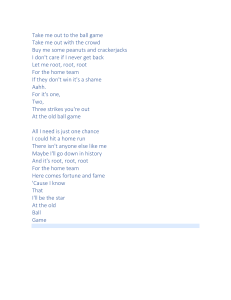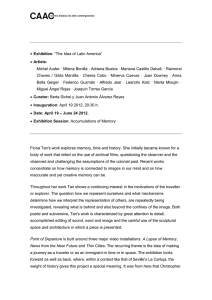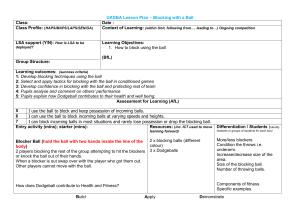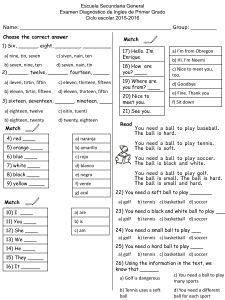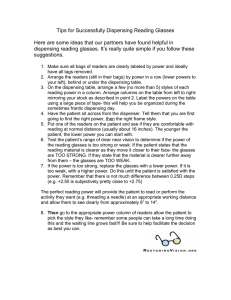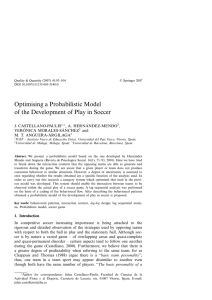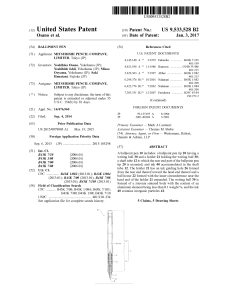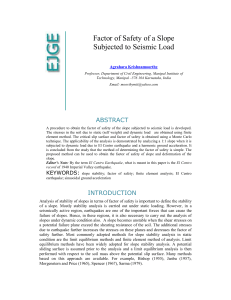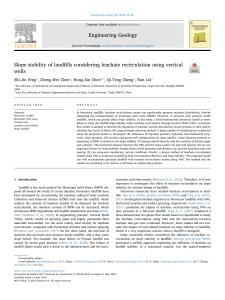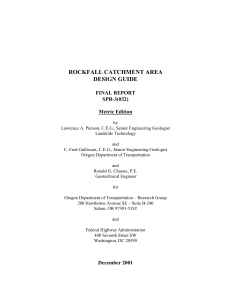a) 6 - Maths Guadalupe Buendía
Anuncio
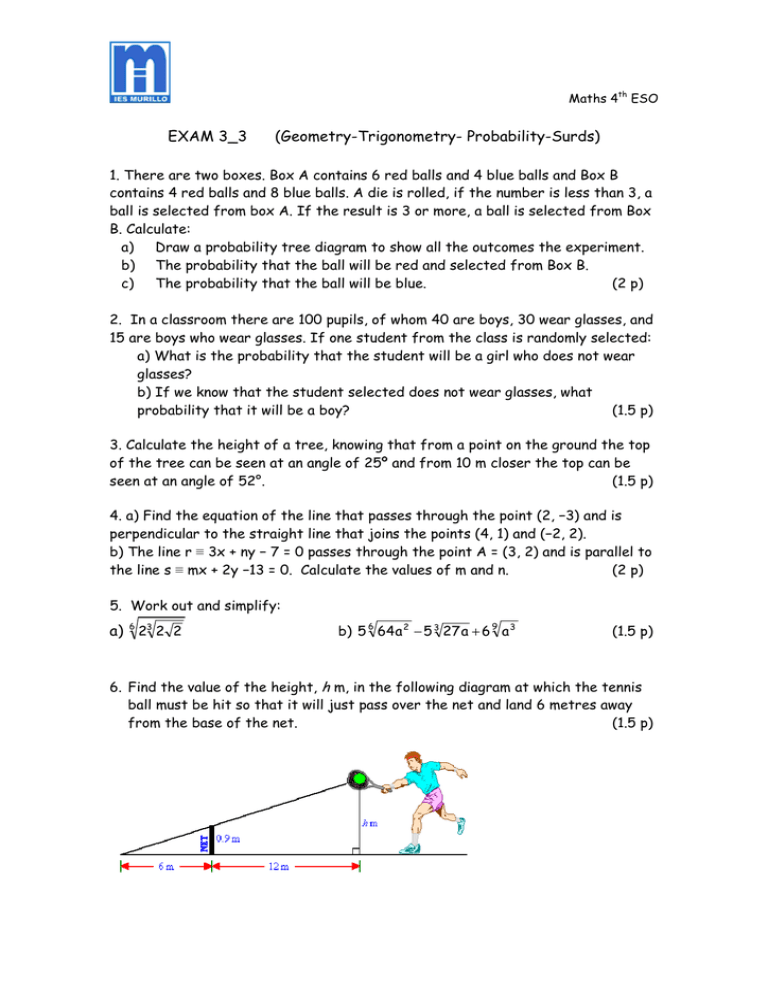
Maths 4th ESO EXAM 3_3 (Geometry-Trigonometry- Probability-Surds) 1. There are two boxes. Box A contains 6 red balls and 4 blue balls and Box B contains 4 red balls and 8 blue balls. A die is rolled, if the number is less than 3, a ball is selected from box A. If the result is 3 or more, a ball is selected from Box B. Calculate: a) Draw a probability tree diagram to show all the outcomes the experiment. b) The probability that the ball will be red and selected from Box B. c) The probability that the ball will be blue. (2 p) 2. In a classroom there are 100 pupils, of whom 40 are boys, 30 wear glasses, and 15 are boys who wear glasses. If one student from the class is randomly selected: a) What is the probability that the student will be a girl who does not wear glasses? b) If we know that the student selected does not wear glasses, what probability that it will be a boy? (1.5 p) 3. Calculate the height of a tree, knowing that from a point on the ground the top of the tree can be seen at an angle of 25º and from 10 m closer the top can be seen at an angle of 52°. (1.5 p) 4. a) Find the equation of the line that passes through the point (2, −3) and is perpendicular to the straight line that joins the points (4, 1) and (−2, 2). b) The line r ≡ 3x + ny − 7 = 0 passes through the point A = (3, 2) and is parallel to the line s ≡ mx + 2y −13 = 0. Calculate the values of m and n. (2 p) 5. Work out and simplify: a) 6 23 2 2 b) 5 6 64 a 2 − 5 3 27 a + 6 9 a 3 (1.5 p) 6. Find the value of the height, h m, in the following diagram at which the tennis ball must be hit so that it will just pass over the net and land 6 metres away from the base of the net. (1.5 p) Maths 4th ESO SOLUTION 1. There are two boxes. Box A contains 6 red balls and 4 blue balls and Box B contains 4 red balls and 8 blue balls. A die is rolled, if the number is less than 3, a ball is selected from box A. If the result is 3 or more, a ball is selected from Box B. Calculate: a) Draw a probability tree diagram to show all the outcomes the experiment. b) The probability that the ball will be red and selected from Box B. 4 4 2 P[R I B] = ⋅ = 6 12 9 c) The probability that the ball will be blue. P[B] = 2 4 4 8 26 ⋅ + ⋅ = 6 10 6 12 45 2. In a classroom there are 100 pupils, of whom 40 are boys, 30 wear glasses, and 15 are boys who wear glasses. If one student from the class is randomly selected: Glasses No glasses Totals Boys 15 25 40 Girls 15 45 60 Totals 30 70 100 a) What is the probability that the student will be a girl who does not wear 45 glasses? P[G I NoG ] = = 0.45 100 Maths 4th ESO b) If we know that the student selected does not wear glasses, what probability that it will be a boy? 25 5 P[B / NoG ] = = 70 14 3. Calculate the height of a tree, knowing that from a point on the ground the top of the tree can be seen at an angle of 25º and from 10 m closer the top can be seen at an angle of 52°. h = x ⋅ tan 52 → → x ⋅ tan 52 = (x + 10 ) tan 25 h h = (x + 10 ) tan 25 tan 25 = x + 10 tan 52 = h x 1.2799 x⋅ = 0.4663 (x + 10 ) → 1.2799x − 0.4663x = 4.663 → 0.8136x = 4.663 x= 4.663 = 5.73 m ⇒ h = 5.73 ⋅ tan 52 = 7.34 m 0.8316 4. a) Find the equation of the line that passes through the point (2, −3) and is perpendicular to the straight line that joins the points (4, 1) and (−2, 2). Slope of the straight line that joins (4,1) and (-2,2): 2−1 1 m= = − ⇒ slope of the perpendicular line: m = 6 −2− 4 6 So, the equation of the line is: y + 3 = 6(x − 2) ⇒ y = 6x − 15 b) The line r ≡ 3x + ny − 7 = 0 passes through the point A = (3, 2) and is parallel to the line s ≡ mx + 2y −13 = 0. Calculate the values of m and n. 3x + ny − 7 = 0 passes through (3,2), so 3 ⋅ 3 + n ⋅ 2 − 7 = 0 → 2 + 2n = 0 ⇒ n = −1 Maths 4th ESO The line r ≡ 3x − y − 7 = 0 → y = 3x − 7 → slope 3 The line s ≡ mx + 2y − 13 = 0 → 2y = −mx + 13 → y = − Parallel lines, so same slope → 3 = − m 13 m x+ → slope − 2 2 2 m → m = −6 2 5. Work out and simplify: a) 6 6 3 23 2 2 = 2 6 6 2 2 ⋅ 2 = 26 2 3 = 9 6 6 6 3 2 6 ⋅ 2 3 = 36 2 9 = 4 2 2 3 6 2 3 b) 5 64a − 5 3 27 a + 6 a = 5 2 a − 5 3 a + 63 a = 10 6 a 2 − 15 3 a + 6 3 a = = 10 3 a − 15 3 a + 6 3 a = 3 a 7. Find the value of the height, h m, in the following diagram at which the tennis ball must be hit so that it will just pass over the net and land 6 metres away from the base of the net. There are two similar triangles, because they have congruent angles. So: h 0.9 0.9 ⋅ 18 = ⇒h= = 2.7 metres 18 6 6
